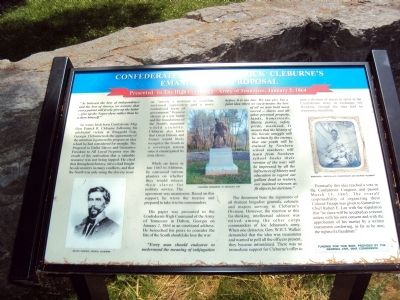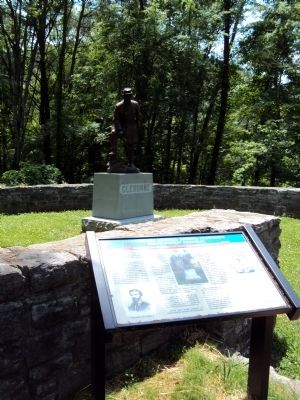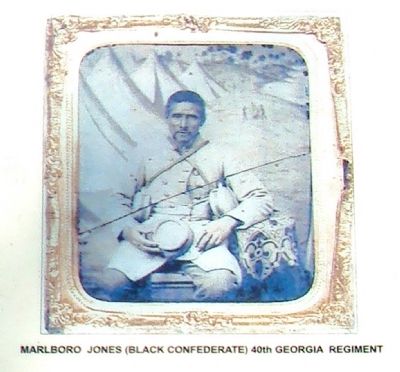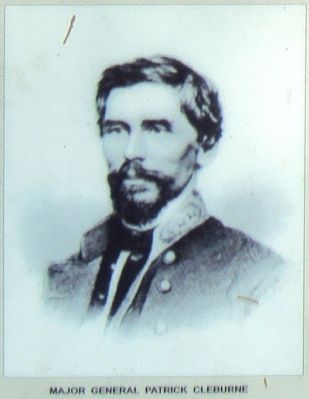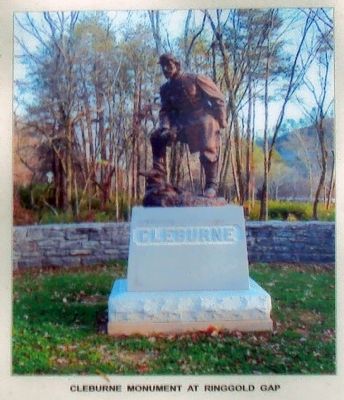Ringgold in Catoosa County, Georgia — The American South (South Atlantic)
Confederate General Patrick Cleburne's Emancipation Proposal
Presented to the High Command - Army of the Tennessee, January 2, 1864
Inscription.
“As between the loss of independence and the loss of slavery, we assume that every patriot will freely give up the latter -- give up the Negro slave rather than be a slave himself.”
So wrote Irish born Confederate Maj. Gen. Patrick R. Cleburne following his celebrated victory at Ringgold Gap, Georgia. Cleburne took the opportunity of the attention it garnered to propose an idea which he had considered for months. The Proposal to Enlist Slaves and Guarantee Freedom to All Loyal Negroes was the result of his realisation that a valuable resource was not being tapped. He cited that throughout history, slaves had fought beside masters in many conflicts, and that the North was only using the slavery issue as “merely a pretense to establish sectional superiority and a more centralized form of government.” Remove slavery as a war factor and the foundations of the North’s argument would crumble. Cleburne also knew that Great Britain and France would likely recognize the South as a sovereign nation once it emancipated its own slaves.
While on leave in late 1863 to Alabama, he canvassed various planters on whether they would release their slaves for military service. The agreement was unanimous. Based on this support, he wrote the treatise and prepared to take it to his commanders.
His paper was presented to the Confederate High Command of the Army of Tennessee in Dalton, Georgia on January 2, 1864 in an emotional address. He beseeched his peers to consider the fate of the South should she lose the war:
“Every man should endeavor to understand the meaning of subjugation before it is too late. We can give but a faint idea when we say it means the loss of all we now hold most sacred -- slaves and all other personal property, lands, homesteads, liberty, justice, safety, pride, manhood. It means that the history of this heroic struggle will be written by the enemy; that our youth will be trained by Northern school teachers; will learn from Northern school books their version of the war; will be impressed by all the influences of history and education to regard our gallant dead as traitors, our maimed veterans as fit objects for derision.”
The document bore the signatures of all thirteen brigadier generals, colonels and majors serving in Cleburne’s Division. However, the reaction to this far-thinking intellectual address was mixed among the other corps commanders of Joe Johnston’s army. When one detractor, Gen. W.H.T. Walker demanded that the idea was treasonous and wanted to poll all the officers present, they became intimidated. There was no immediate support for Cleburne’s offer to train a division of slaves to serve
in the Confederate army in exchange for freedom, though the idea had no treasonous intentions.
Eventually this idea reached a vote in the Confederate Congress and passed March 13, 1865. The overall responsibility of organizing these Colored Troops was given to General-in-Chief Robert E. Lee with the stipulation that “no slave will be accepted as a recruit unless with his own consent and with the approbation of his master by a written instrument conferring, as far as he may, the rights of a freedman.”
Funding for this sign provided by the Georgia Civil War Commission.
Topics. This historical marker is listed in these topic lists: African Americans • War, US Civil. A significant historical month for this entry is January 1872.
Location. 34° 54.577′ N, 85° 6.167′ W. Marker is in Ringgold, Georgia, in Catoosa County. Marker is on U.S. 41, 0 miles south of Crabtree Drive, on the left when traveling north. Touch for map. Marker is in this post office area: Ringgold GA 30736, United States of America. Touch for directions.
Other nearby markers. At least 8 other markers are within walking distance of this marker. The Battle of Ringgold Gap (here, next to this marker); Atlanta Campaign (here, next to this marker); General Patrick R. Cleburne Memorial (a few steps from this marker); a different marker also named The Atlanta Campaign (a few steps from this marker); Ringgold Gap
(a few steps from this marker); Ireland's New York Brigade (about 300 feet away, measured in a direct line); Historic Ringgold (about 600 feet away); The Great Locomotive Chase (approx. half a mile away). Touch for a list and map of all markers in Ringgold.
Credits. This page was last revised on June 16, 2016. It was originally submitted on June 21, 2013, by Jamie Abel of Westerville, Ohio. This page has been viewed 1,277 times since then and 30 times this year. Photos: 1, 2, 3, 4, 5. submitted on June 21, 2013, by Jamie Abel of Westerville, Ohio. • Craig Swain was the editor who published this page.
